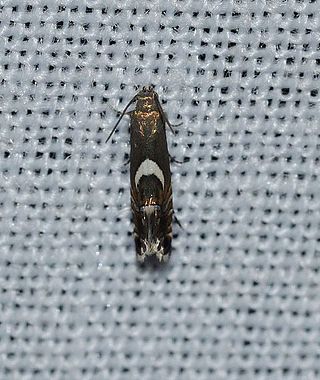
Lepidoptera or lepidopterans is an order of winged insects that includes butterflies and moths. About 180,000 species of the Lepidoptera have been described, representing 10% of the total described species of living organisms, making it the second largest insect order with 126 families and 46 superfamilies. and one of the most widespread and widely recognizable insect orders in the world.

Moths are a group of insects that includes all members of the order Lepidoptera that are not butterflies. They were previously classified as suborder Heterocera, but the group is paraphyletic with respect to butterflies and neither subordinate taxa are used in modern classifications. Moths make up the vast majority of the order. There are thought to be approximately 160,000 species of moth, many of which have yet to be described. Most species of moth are nocturnal, although there are also crepuscular and diurnal species.

Lymantria dispar, also known as the gypsy moth or the spongy moth, is an Eurasian species of moth in the family Erebidae. Lymantria dispar is subdivided into several subspecies, with subspecies such as L. d. dispar and L. d. japonica being clearly identifiable without ambiguity. Lymantria dispar has been introduced to several continents and is now found in Europe, Africa, Asia, North America and South America. The polyphagous larvae live on a variety of deciduous and coniferous trees and can cause severe damage in years of mass reproduction. Due to these features, Lymantria dispar is listed among the world's 100 worst invasive alien species.

The luna moth, also called the American moon moth, is a Nearctic moth in the family Saturniidae, subfamily Saturniinae, a group commonly named the giant silk moths.

The Pyralidae, commonly called pyralid moths, snout moths or grass moths, are a family of Lepidoptera in the ditrysian superfamily Pyraloidea. In many classifications, the grass moths (Crambidae) are included in the Pyralidae as a subfamily, making the combined group one of the largest families in the Lepidoptera. The latest review by Eugene G. Munroe and Maria Alma Solis retain the Crambidae as a full family of Pyraloidea.

Saturniidae, members of which are commonly named the saturniids, is a family of Lepidoptera with an estimated 2,300 described species. The family contains some of the largest species of moths in the world. Notable members include the emperor moths, royal moths, and giant silk moths.

The Glyphipterigidae are a family of small moths commonly known as sedge moths, as the larvae of many species feed on sedges and rushes. More than 500 species have been described in the family.
Stag Lane Aerodrome was a private aerodrome between 1915 and 1933 in Edgware, north London, UK.

Diploschizia is a genus of sedge moths. It was described by John B. Heppner in 1981. It is mostly treated as a synonym of Glyphipterix.
Diploschizia glaucophanes is a species of sedge moth in the genus Diploschizia. It was described by Edward Meyrick in 1922. It is found in South America.
Diploschizia habecki is a species of sedge moth in the genus Diploschizia. It was described by John B. Heppner in 1981. It is found from southern Georgia to central Florida.
Diploschizia lanista is a species of sedge moth in the genus Diploschizia. It was described by Edward Meyrick in 1918. It is found in North America, including Florida, Georgia, Oklahoma, South Carolina, North Carolina, Texas and Louisiana.
Diploschizia minimella is a species of sedge moth in the genus Diploschizia. It was described by John B. Heppner in 1981. It is found in the US state of Florida.
Diploschizia regia is a species of sedge moth in the genus Diploschizia. It was described by John B. Heppner in 1981. It is found in Florida.
Diploschizia mexicana is a species of sedge moth in the genus Diploschizia. It was described by John B. Heppner. It is found in Mexico.
Diploschizia urophora is a species of sedge moth in the genus Diploschizia. It was described by Walsingham in 1914. It is found in Central America.
Diploschizia kutisi is a species of sedge moth in the genus Diploschizia. It was described by John B. Heppner in 1997. It is found in Florida.
Diploschizia seminolensis is a species of sedge moth in the genus Diploschizia. It was described by John B. Heppner in 1997. It is found in the US state of Florida.








